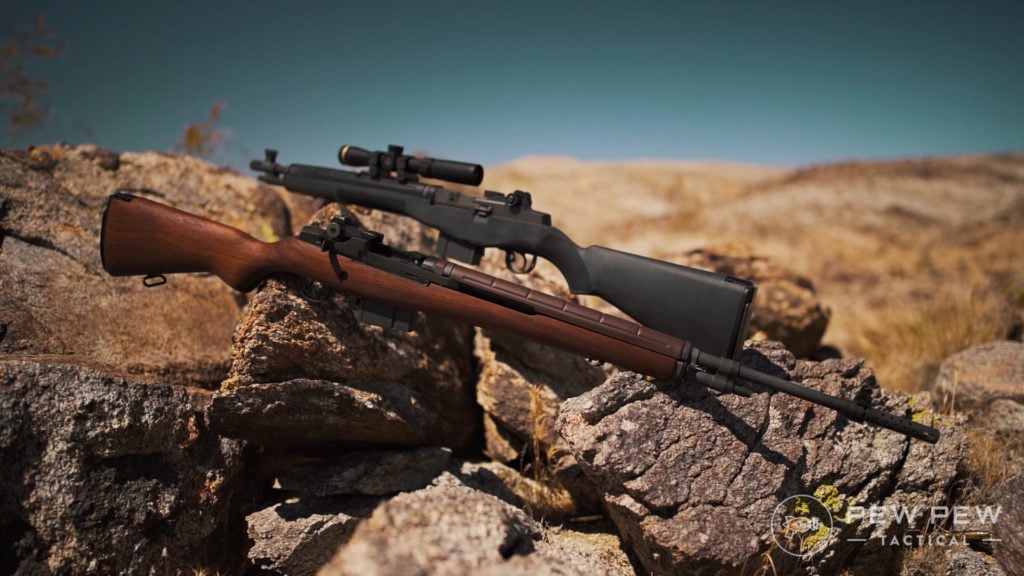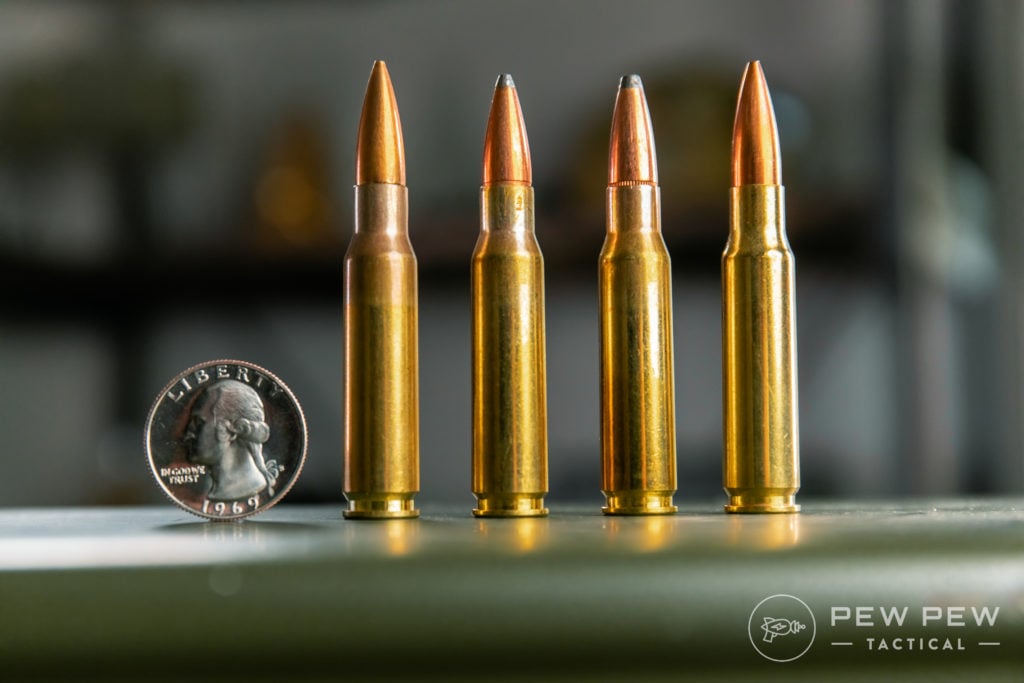Is the steel and wood Springfield Armory M1A still a viable battle rifle?
Stick around, because we put a ton of .308 through a National Match M1A and a SOCOM 16, and had a profoundly weird experience.

First things first: Historical firearms are cool as hell, and there’s nothing quite like owning, holding, or shooting a wood-clad gat that’s got a story to tell, if only it could speak.
The M1A, obviously a civilian variant of the iconic M14, fits squarely in that niche – you can check our full video over on our YouTube Channel!
Table of Contents
Loading...
A Bit Of Background
Now, obviously the M1A is merely the civilian variant of the iconic M14, and the M14 itself is essentially only a slightly modified M1 Garand that was developed after WW2 to fill the niche for a fully automatic battle rifle.
While the countries in the newly formed North Atlantic Treaty Organization quickly agreed on a need to standardize small arms cartridges, a debate ensued over which exact cartridge that should be.
While the British focused on a smaller .280 cartridge out of concern for controllability in full auto, the US refused to adopt anything smaller than .30 caliber, citing concerns over diminished stopping power.

Fast forward a bit past a lot of bureaucracy and a point where the US almost adopted the FN FAL, and finally we have NATO’s adoption of the 7.62x51mm cartridge as its official battle rifle round – and with it, the US adopted the M14 in the late 50s.
The M14, in theory, would simplify the makeup of the weapons fielded by the standard American infantry squad.
The leading brilliant minds of the time legitimately saw a future in which the M14 would replace the M3 grease gun and Thompson submachine guns, the BAR as a squad automatic weapon, the Springfield 1903 as a marksman rifle, and the M1 Garand and M1 carbine – a total overhaul of the ammunition and parts needed to keep a squad well supplied and operational.

The gun was first fielded in Vietnam, and although 7.62 NATO proved great at punching through thick vegetation, the gun’s overall length was poorly suited for jungle warfare, it was basically uncontrollable in full auto, it’s wood stocks were subject to swelling from jungle humidity, which affected zero, and a DOD report found that the rifle overall was inferior to both the M1 Garand it descended from, and the soon to be introduced M16.

What About Today?
So where’s that leave us?
Why, with an ensuing internet argument, of course!
We’ll just say this: The M14 and M1A have incredibly vocal supporters and detractors both – and if you have the misfortune of wading into Mekong Delta of that online shit-flinging fest, it’s probably going to be quite hard to discern how these guns actually perform in real life.
Springfield Armory was kind enough to send us both a National Match M1A and a SOCOM16 to try out for ourselves – and we hoped that by the end, we’d have enough insight to give you a reasonable everyman opinion.
Considering that you have folks claiming that these are sub MOA guns at 1,000 yards with irons on one side of the debate, and uhhhhh some nerd that won’t shutup about how the US should have adopted the FAL over the M14 on the other.

The Two Models
The National Match M1A is, according to Springfield, hand-built to win competitions.
Prices accurate at time of writing
Prices accurate at time of writing
The gun’s action is glass bedded into the walnut stock, which overcomes the traditional issue M14s face with poor fitment apparently affecting accuracy.
The gun’s also got a 5lb two-stage trigger, which might feel sort of heavy, but it’s really obvious when it’s going to break and there’s very minimal creep on the takeup.

The SOC16 is obviously a bit more compact and includes a 16” barrel in a black polymer stock with the iconic SOC16 muzzle brake upfront.
Prices accurate at time of writing
Prices accurate at time of writing
The gun also has a scout style picatinny mount just forward of the action, allowing for the addition of red dots or scout scopes if that’s your jam.

Ergonomics
First things first – in all honesty, these rifles are quite dated in terms of design ergonomics – as again, they’re civilian M14s, and the M14 was dated design-wise at the time even compared to the AK and FAL.
Considering you’ll be rocking the ergonomics of an 80 some odd-year-old rifle design, you can expect to feel out of place if you’re the type of dude that’s used to adjustable length of pull and a c-clamp style grip.
The rifles are heavy and quite cumbersome – weighing in at 8lbs for the SOC16 and 10lbs for the National Match, both unloaded.
Because of the op-rod placement, you’re likely going to have to jump your support hand out way further than what feels natural if you’re used to firing modern carbines – otherwise, you’ll be in for quite a shitty surprise when the gun bites you.

However, the sling mount kinda gets in the way of what, for me, feels like a natural hand placement – and you’ve got to keep your fingers away from the op-rod all the same.
The M1A’s safety is located within the trigger guard itself, and is essentially a metal tab that you press forward to disengage.
Again, a bit of antiquated design here – I don’t particularly care for a safety mechanism that I have to get my finger near the trigger to operate, and the lever itself is quite stiff.
Kinda sketchy, and I prefer to use my left thumb to flick it forward.

The swell of the rifle’s stock also creates a fulcrum point around your hand itself.
Whereas an AR platform is going to recoil directly back into the buffer tube, the M1A essentially uses your dominant hand as an anchor point for the muzzle when it climbs upwards.

I also find that for me personally, the combination of hand and head placement when shooting from a rest position always winds up grabbing a bit of facial hair that the rifle takes with it when it fires, so make of that what you will.

Additionally, the magazines are a bit wonky to insert at first.
You’ve got to rock them into the receiver sort of like an AK, but because the guns ship with short 10 rounders, you’ve really got to drive the front notch of the mag deep into the mag well, rock the rear of the mag back towards the trigger, and simultaneously push up to get the magazine seated correctly.
It’s not the end of the world, and it does get easier over time as the mags get broken in.

So, yes – the design of the rifles isn’t super comfortable and feels antiquated, well, because it is.
But how do they shoot?
Shooting!
We took these guns out to the desert to ring some 200-yard steel, and in all honesty…the results were not fantastic.

It seemed like no matter what type of .308 ammunition we used, from shitty PRVI to decent PM to federal gold medal match, we’d hit 1or 2 shots every 3-4 rounds using consistent holds on our steel target.

Admittedly, we are not marksmen, and while we all have a good amount of long-range shooting experience, our inability to hit relatively close targets with these guns seemed pretty damn wild.
The M1A’s worst critics online will tell you that the gun’s design itself literally prevents them from being accurized, due to the mechanics of how the rifle’s receiver fits into the stock itself.
There’s also an infamous study on the M14 that essentially says the same thing, noting that the US Army tried for a few decades and concluded, a couple million dollars later, that the M24 was a better weapon system than the marksman-tier M14 they tried to create.

Could it really be us? Do we not understand the point of aim with M14 irons? Are they that different from the ARs and AKs we’re much more familiar with? Are we posers? Comment below if you think we’re posers.
We weren’t sure, but we did find that both the National Match M1A and the SOCOM 16 performed about the same in this department – with the SOC16’s ironsights being a bit worse considering they’re thicker and obscure most of the target at 200 yards. (You know, because it’s a CQB gun)

After a few mags, we decided to setup a shooting mat and rest to take some prone shots with an optic mounted to the SOC16’s scout mount to see if the irons themselves were just inexplicably way off.

Unfortunately, we still weren’t getting great results, and the forward-mounted Picatinny rail on the SOC16 means that you’re essentially relegated to scout scopes with good eye relief.
Again – we totally accept that we are by no means amazing shooters, but this shouldn’t be that hard. So what’s going on here?
Considering the fact that it was 100+ degrees on our shoot day and firing a shitton of .308 on guns with meat tenderizers on their buttplates isn’t the most pleasant thing in the world, we resigned ourselves to chill on the M1As and take them to a local range to shoot groups and get them dialed in.
Range Day #2
Fast forward to our next shoot day! This time, we shot 100 yard groups with irons from the bench, and… the results were still pretty bizarre.
As you can see… the shot placement was all over the place.

One of the weirdest parts of the entire experience was the tendency for both guns to pull off consecutive rounds either through the same hole or touching one another, only for the next round to be a complete flier somewhere else on the paper.

Again, we’re not so arrogant as to think that this isn’t our fault – but if so, why / how were we putting 2 rounds through the same hole only to completely fuck up the next round by several inches? At 100 yards from bench?
That seems pretty unlikely.
Troubleshooting
Not wanting to publish a pretty damning review on 8 MOA guns, we wondered if there might be something wrong with the rifles themselves. We therefore reached out to Springfield to see if they had any idea what the case might be.
While they were alarmed at our results, they offered to bring the guns back and test them at their facilities to ensure we didn’t get flawed rifles for whatever reason.
Springfield’s techs looked the guns over and purportedly found zero issues with any aspect of them.

Springfield then mounted optics to the rifles using a 4th Gen Steel Receiver mount and tested them thusly.
Prices accurate at time of writing
Prices accurate at time of writing
The National Match came in at 1.25 MOA with a Vortex 4-16x optic, and the SOC16 shot 2MOA with a Vortex 1-6 both at 100 yards.
Again, obviously much better than the results that we were getting in the two different times we shot the guns previously.

At this point, we were pretty blown away.
Is it really us? Do we really just suck that hard?
Springfield offered to send the guns back to us for another round of testing, and we accepted. They even included the optics and mounts to ensure we’d be able to repeat their results.
Fast forward to range trip number 3, and close to 900 rounds of .308 later aaaaaaaaaaaaaaand we were finally able to get some usable numbers out of these guns!
Sweeet Jesus thank you!
Range Trip #3
With the Vortex optics mounted we were now shooting about 1.5MOA out of the National Match, and ~2 MOA out of the SOC 16 using 168gr Gold Medal Match ammo.
PRVI 145 and 180 grain out of the SOC16 both still felt subpar however, and PMC Bronze was decent but did have a flier in the group you see on screen.

The National Match didn’t much like PRVI 145, but did okay with with PRVI 180, because literally nothing about any of this makes sense.
PMC was okay and Match was, of course, the best.

We should note though that you’ll likely want to invest in a cheek riser if you wind up using an optic on these rifles, as they tend to sit quite high above the bore.
By the Numbers
Reliability: 5/5
For all of the weird issues we had with the M1As, reliability in terms of operation wasn’t one of them. We did experience one light primer strike on some of the poorer PRVI ammo, but are good to go outside of that.
Ergonomics: 3/5
This feels a little bit odd to grade with a number value, as the rifle’s design is quite dated. It was par for the course during the 40s, but is it fair to judge an antiquated set up by modern standards? The gun will work just fine if you adapt your shooting style to it, but it is not the most comfortable experience in the world.
Accuracy: ?/5
We’re genuinely super confused about what happened with the accuracy tests of the guns, and don’t feel particularly comfortable assigning this area a grade while the results were inconclusive.
Customization: 5/5
There are a ton of aftermarket accessories available for the M1A, such as radically different chassis that update its design ergonomics to something that feels much more modern if you can’t stand the old-school vibe.
Value: 3/5
The M1A is a little bit pricey depending on model, but if you’re in the market for a .308 American service rifle, it’s essentially your only option.
Overall: 3/5
Parting Shots
Again…highly recommend you check out the video so you can see everything in motion.
So the guns did okay and shot pretty close to what Springfield reported with the addition of optics.
However, that makes the entire ordeal feel that much stranger?

We still aren’t quite sure what to make of this entire experience, in all honesty.
Prices accurate at time of writing
Prices accurate at time of writing
We really hope we don’t accidentally end up summoning the M14 defense squad by even suggesting that these guns are not the absurdly accurate sniper platforms it feels like a segment of pop culture has made them out to be, and for the umpteenth time we’re readily willing to accept that the problem may very well have been us.

What sticks out as extremely odd for me personally though, is that we’ve never experienced issues quite like this with any of our other .308 guns, and the issues occurred across multiple reasonably experienced shooters.
It also seems unlikely that we’d be able to get two rounds to touch back to back if we weren’t decent shots to begin with, only to have a subsequent round end up nowhere near the previous two.

Springfield’s lead tech also managed to shoot a 1.25” group with the national match using irons, so blaming the iron sights doesn’t seem quite right either – although I think it’s fair to assume a tech at springfield is likely a goddamn pro with the M1A.
Prices accurate at time of writing
Prices accurate at time of writing
Truthfully, we have no idea, and we actually deliberated for a while on what approach we wanted to take with this review – because at the end of the day, it’s still sort of inconclusive.
It’d be easy to pretend like the entire gaff just never happened, but that’s super disingenuous, and we try to be as real with y’all as possible.
We will say that Springfield’s responsiveness in helping us sort out what was going on was fantastic, and worth letting all of you know about.
If for whatever reason you do have issues with your guns, it’s nice to know that the manufacturer is going to look into the issue and treat your concerns as valid.

That being said, it’s certainly frustrating to present a gun review where the results are sort of inconclusive.
Are we just miserable with iron sights? Did the guns get banged up in shipping? Are the guns haunted? Was mercury in retrograde? We may never know.
As for the rifles themselves – they certainly have their niche. Guns that are a nod to the past are definitely a blast to own and shoot, and if you’re considering purchasing an M1A, we’d imagine it’s likely because you have some sort of sentimental or historical interest in the rifle – not because you’re looking for something that’s going to outperform an AR-10.
Additionally, most models of the M1A are naturally featureless if that’s a concern for you, although it certainly would have been fun to play with some of the wilder EBR style chassis.

That being said, the M1A is still a blast if you want a big, chunky battle rifle with ties back to the iconic M14 – though we’d certainly still recommend finding a way to try one out before you buy it just to make sure you know what exactly you’re getting yourself into.
Let us know what you think of the M1A and how it went all wonky for us. And check out the Best .308 Ammo, Best AR-10s, and Best 7.62×51 Battle Rifles.
The post [Review] Springfield M1A: SOCOM 16 & National Match appeared first on Pew Pew Tactical.